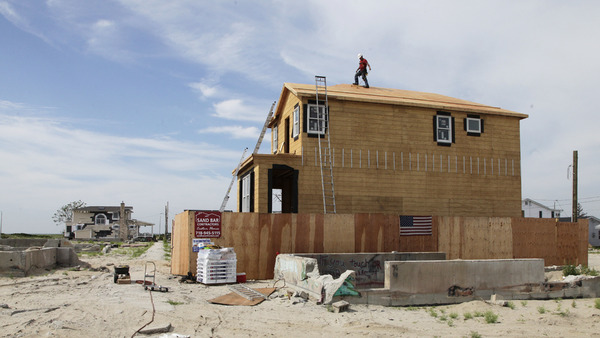Insurance Coverage Disputes
A Wave of Insurance Coverage Issues After Superstorm Sandy
Finley T. Harckham and Dennis J. Artese - Property Casualty 360°
September 15, 2014

Superstorm Sandy, like many major natural disasters before it, has given rise to a number of unique and important commercial property insurance coverage issues. As the storm's two-year anniversary approaches, most of these issues are just starting to wind their way through the courts.
Named Storm Deductibles
Many commercial property insurance policies provide for higher “named storm” or “hurricane” deductibles than standard per occurrence deductibles. While Sandy did at one time possess hurricane characteristics, it lost those traits prior to making landfall, and the National Weather Service downgraded it to a post-tropical cyclone hours before it came on shore in Brigantine, New Jersey. This is significant for coverage purposes, particularly where policies define “named storm” to mean a hurricane, tropical cyclone or tropical depression, none of which accurately describe Superstorm Sandy.
Some insurance companies have set out to apply so-called “hurricane” or “named storm” deductibles to covered Sandy losses, despite the National Weather Service’s classification of Sandy as a post-tropical cyclone, and despite admonishments by the governors of affected states not to do so. The courts have not been receptive.
In one post-Sandy case in New Jersey, the policy at issue defined "named storm" as one declared to be a named tropical storm or hurricane by the U.S. National Weather Service or other government authority including hurricane or tropical storm spawned tornado(s) or microburst(s). The named tropical storm or hurricane … ends when the National Weather Service officially declares the named tropical storm or hurricane permanently downgraded to a tropical depression.
The court denied the insurance company’s motion to dismiss, holding that, if later proven to be true, plaintiff’s allegation that “[u]pon landfall in New Jersey, Sandy was characterized as a post-tropical storm,” easily establishes that the named storm deductible is not applicable to plaintiff’s claim.
In another case, a California court took a different approach, finding an issue of fact as to the efficient proximate cause of the loss: (1) post-tropical cyclone; or (2) storm surge that developed when Sandy was still a hurricane.
Civil Authority Coverage
Many businesses that did not suffer property damage at their insured locations resulting from Superstorm Sandy did nonetheless suffer a loss of business income resulting from the storm. While “standard” business interruption coverage would not apply under such circumstances, other time element overages, such as “civil authority” coverage, may apply. Civil authority coverage typically is triggered where access to the insured premises is impaired by the action/order of a civil authority, such as a city’s mayor. While direct physical loss or damage caused by a covered cause of loss still is required, that loss or damage can occur away from the insured premises, and the damaged property need not be owned by the insured. However, policyholders who do not have flood coverage may not be able to take advantage of an order of civil authority if the order to vacate was related solely to flooding, and not also to concerns about wind damage. Non-specific orders can lead to coverage disputes.
Service Interruption Coverage and Ensuing Loss
Another form of “off premises” time element coverage relied on by many businesses in the wake of Superstorm Sandy is known as service interruption coverage. This covers business interruption losses resulting from damage to personal property of a utility necessary to supply the insured premises with things such as power, water, communication, natural gas, sewage and Internet access. Typically, the property damage at the utility must be caused by a covered cause of loss under the policy.
In some areas of New York City and other locations affected by Sandy, certain utilities preemptively shut down power in order to preserve the integrity of the electrical system during the storm. New Jersey and New York courts have so far appeared to split on the question of whether such a preemptive shutdown is a covered event.
Moreover, although it has been widely reported in the media that a massive transformer explosion occurred at the 14th Street Con Edison plant, knocking out power to tens of thousands of customers in Lower Manhattan on the evening of October 29, 2012, many insurance companies have argued that this was mere electrical arcing caused by flood, which is excluded under many policies, not an “ensuing loss” in the form of an explosion that triggered service interruption coverage. That issue is currently making its way through the New York courts in a number of different cases involving losses of several millions of dollars. The court in one case held that the undisputed evidence demonstrated that the cause of the Bowling Green network outage in lower Manhattan was flooding; however, there was no discussion about the transformer explosion or other ensuing loss.
Conclusion
It should hardly come as a surprise that a storm as massive and unique as Sandy has given rise to unique and complex insurance coverage issues. Some of these issues may take years to resolve. With perseverance and strong coverage counsel, policyholders stand an excellent chance of succeeding on the unique coverage issues arising out of Superstorm Sandy.
The content of this article is intended to provide general information and as a guide to the subject matter only. Please contact an Advise & Consult, Inc. expert for advice on your specific circumstances.
SOURCE: www.propertycasualty360.com
